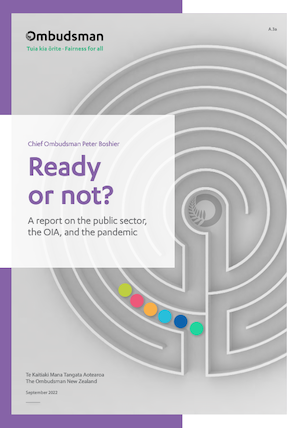
COMMENTARY: By Gavin Ellis
New Zealand’s Ombudsman, Peter Boshier, has given government agency media teams a well-deserved kick up the fundamental over some of their dealings with journalists.
Last week he released his report Ready or not? Thematic OIA compliance and practice in 2022. It is highly critical of the way the teams handle some media requests for information. Incredibly, many did not see such requests as falling under the Official Information Act.
The 66-page report revisits 12 government agencies that were investigated by his predecessor in 2015 and it picks out media teams for particular scrutiny.
“Most of the agencies I investigated have a Media Team responsible for handling information requests from the news media. These Media Teams operate separately from centralised OIA Teams, which typically process information requests from the public.
“While separating requests in this way is not unreasonable in itself, I am concerned that some of the practices associated with this method of request handling has helped to create a false perception that media requests are not OIA requests and, as a result, that agencies do not need to adhere to OIA obligations when handling them.”
The Ombudsman’s report states unequivocally that media information requests are OIA requests, with the core legislative obligations that those confer.
Some excellent service
As one might expect, there were examples of excellent service provided by media teams. He singled out the Ministry of Health Manatū Hauora and the Public Service Commission Te Kawa Mataaho.

The former was praised for its information handling during the pandemic, while the latter’s performance should be a given — it is the lead agency on implementation of the government’s commitments under the international Open Government Partnership.
However, he didn’t mince words over some of the actions of media teams: “In most of the agencies I investigated, I saw evidence of breaches of the law.”
Given some of Peter Boshier’s other findings, that conclusion should not come as a surprise.
“I was deeply concerned to find that the responses from some agencies to my investigation suggested they did not consider that media information requests fall under the OIA. As a result, it had become embedded in the culture and practice of staff in some Media Teams to refuse information without providing a valid reason under the OIA.
“Those staff considered that the OIA did not apply to their actions and decisions on information requests from the media—in stark contrast to their counterparts in OIA Teams operating in the same agency.”
When he gave the agencies a preliminary assessment of this aspect of their operations, one replied that “placing the constraints of the OIA over the work of the ministry’s media team will add a layer of formality over those relationships and despite the best endeavours of staff, will add to the time required to respond.”
Another said it would affect relationships with the media.
Misperceptions a problem
The Ombudsman disagrees with that assessment. And he went further, saying the perception that the OIA did not apply to media information requests was “simply incorrect”. He saw the misperception as the cause of media teams operating contrary to the law.
He called on the leaders of errant agencies to take immediate responsibility for a cultural shift within media teams and ensure policy, practice, and process changes were made to ensure compliance with the law.
The most common breaches have been failure to give reasons for refusing to give information, and failure to acknowledge a right of appeal to the Ombudsman.
He found distinct types of breaches of the requirement to give reasons for refusal:
- The agency acknowledged that information was being refused, but the reason given for refusal was not a valid one under the OIA, e.g. “That information is not centrally located’ and “We’re unable to provide that information within the given timeframe”.
- No information was given and it was not acknowledged there had been a refusal.
- The agency responded with general information but did not actually answer the question, and it was not acknowledged there had been a refusal.
The investigation revealed a curious relationship between media teams and an agency’s OIA team.
Media teams used a “triaging system” to determine when it was more appropriate for the OIA Team to handle the request. The 12 agencies’ media teams “triaged” requests in a broadly similar manner. Where the request could be answered by the media team within the requester’s specified timeframe — typically a matter of hours or days, to accommodate media deadlines — it would be answered by the media team.
Lack of clarity
If the request could not be answered within the timeframe specified by the requester because it was complex, voluminous, or if it was anticipated that withholding grounds may apply, the media team typically advised the requester that their request would need to be handled by the agency’s OIA team.
Some media teams would tell the requester that their request “would need to be an OIA” without making it clear whether they had forwarded the request on, or whether the requester would need to resubmit their request.
“This language and the practice of separating requests in this way is problematic,” the Ombudsman said, “because it helps propagate the misapprehension that quick turnaround ‘media requests’ are distinct from other information requests. It also implies that the OIA does not apply to them, while ‘formal’ OIA requests ‘must’ go through a regimented, multi-stage process which invariably takes the maximum statutory time limit (20 working days).”
The report is couched in measured terms but I cannot help but feel this two-tiered system is a weapon used against the media. Twenty working days is as good as a refusal in the fast moving world of digital daily news. Peter Boshier acknowledges as much in his report.
“Where requested information cannot be provided in a matter of days, but the journalist finds it untenable to wait up to 20 working days, there is rarely a middle ground; the request is sometimes abandoned by the requester. It is here that Media Teams’ commitment to responding in only hours or days may be a double-edged sword: when Media Teams cannot reply within the media’s specified timeframe, the request may not get answered at all.
Few agencies I investigated have effective mechanisms in place for providing information ‘without undue delay’, or under urgency if it falls outside the media’s requested timeframe. This ‘now or never’ approach to media information requests reinforces the false perception that the OIA requires a separate process for handling ‘formal’ information requests, and it creates a potential gap in the provision of information which is of great concern to me and does not serve the public interest.”
And he concedes that the two-tiered system fuels perceptions that the Official Information. Act is used as a shield by delaying or frustrating requests for information. However, he denies that the Act itself is at fault. It does not prescribe the processes to be followed, “and an agency’s OIA process can be as agile, flexible and swift as the agency is prepared to make it.”
Loopholes to be exploited
He is absolutely right. What he does not acknowledge, however, is the fact that the sometimes loosely-defined and voluminous reasons for refusing information that are contained in the legislation send a signal to agencies and their employees that there are loopholes to be exploited.
And even outside the OIA there are pressures that work against its spirit. For example, the Ombudsman notes that agencies employ a blanket approach to responses sent to ministers ‘for your information’ under the No Surprises Principle. Even when no input is required from the minister, the material is usually sent three to five days before it is due to be sent to the requester.
The Ombudsman puts it rather delicately — “[It] may lead to the perception that input from the Minister is being sought by the agency that might alter the decision planned for release” — but I read that as saying nothing contentious is released without political approval.
Throughout the report there are sensible and workable solutions to the problem that the Ombudsman has uncovered. Training, policy guidelines and culture change led from the top are all ways in which the spirit of the OIA can be met.
And media teams can start obeying the law.
Dr Gavin Ellis holds a PhD in political studies. He is a media consultant and researcher. A former editor-in-chief of The New Zealand Herald, he has a background in journalism and communications — covering both editorial and management roles — that spans more than half a century. Dr Ellis publishes a website called Knightly Views where this commentary was first published and it is republished by Asia Pacific Report with permission.












































